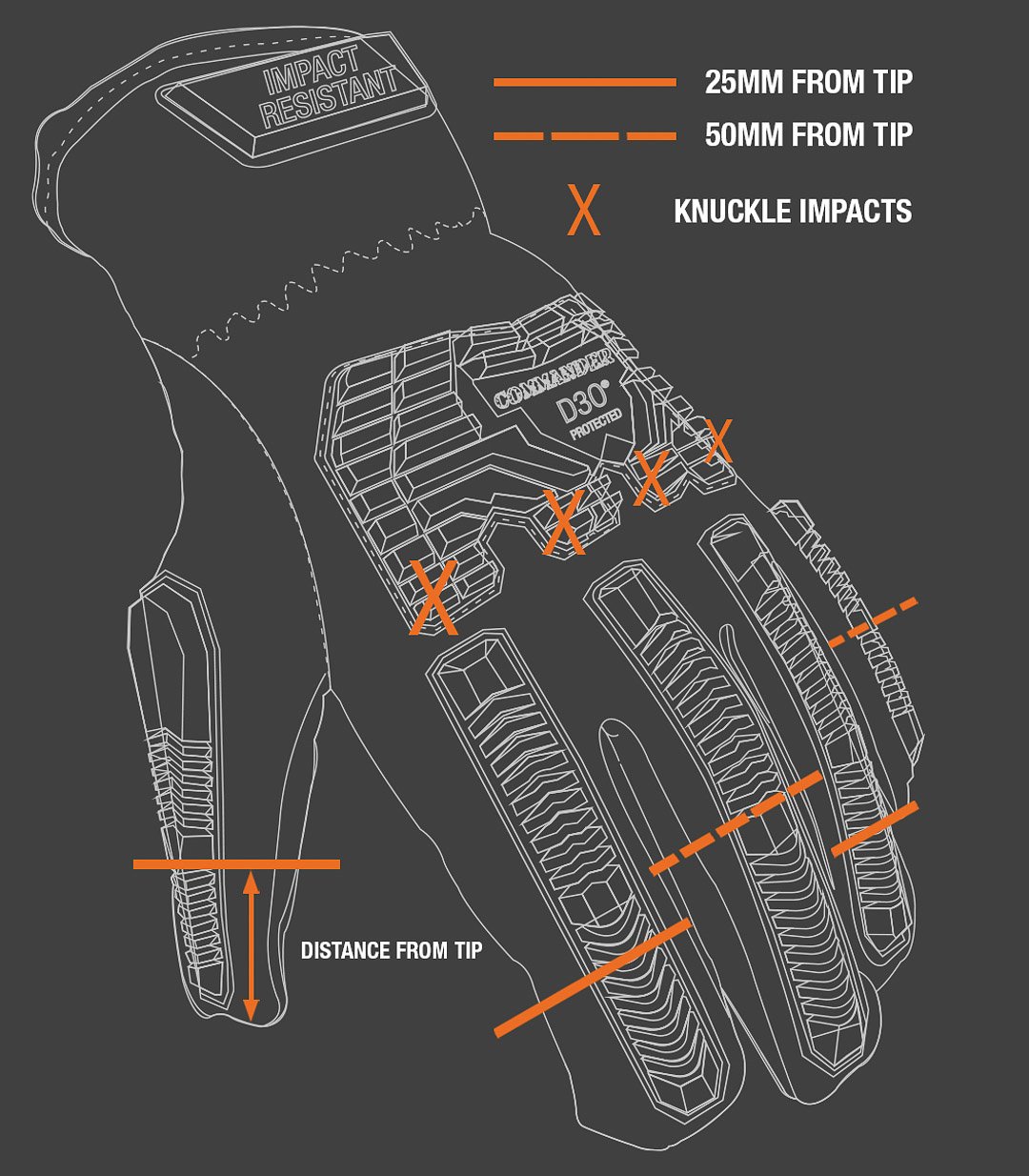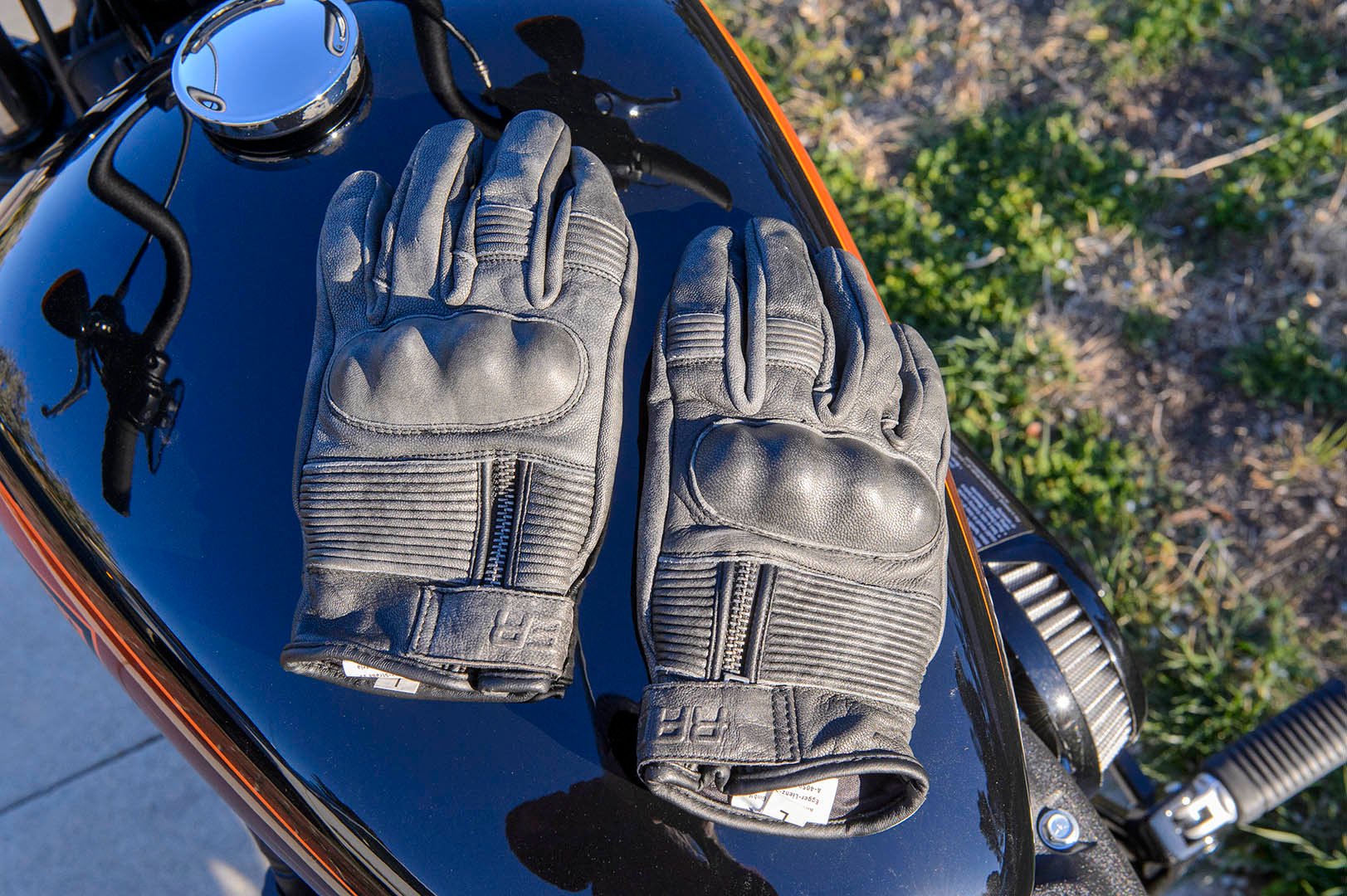There are several sets of standards you may see listed for different gloves when you’re shopping around. So, we want to explain the meaning of the competing motorcycle gloves safety standards.
Time was, if you wore leather gloves of almost any description, that was about all you knew, and that was about as good as it gets for riding—no more. These days, motorcycle safety performance standards measure gloves’ protective properties against various hazard types in specific, quantitative, and qualitative ways.

Depending on the kind of riding you do, finding the gloves that you determine best protect your hands is easier when you’re familiar with which performance standards measure what and how.
For example, if your focus is on off-road riding in rocky, wooded terrain where your hands could be out there in harm’s way from trailside limbs and brush while underway, and rocks and other inhospitable terrains in the event of a fall. Impact protection for your fingers and back of the hand may be an important consideration for you.
Motorcycle glove safety standards exist for North America and Europe. The standards available for use in North America are based on the type of hazard anticipated; the European CE standard (Conformité Europénne; French for European Conformity) is specific to end-use.
For example, a North American standard is the ANSI/ISEA 138 Impact Standard, adopted in 2019. The European standard adopted in 2015 for gloves intended for motorcycle use is CE EN 13594-2015.
The European standard is mandatory for on-road motorcycle gloves sold in some European jurisdictions—as of this writing, 33 countries require CE marking. The CE standards in and of themselves do not require motorcyclists to use gloves in all jurisdictions. Rather, they establish performance criteria for gloves sold for use as motorcycle gloves.
“Some” applies because not all parts of the EU necessarily require motorcyclists to wear gloves in the first place, nor require that any gloves that may be worn meet CE standards. On the other hand, in 2017, France mandated that road-going motorcyclists must wear gloves, and that the gloves meet CE standards.
The European markets that require the use of products meeting the CE standards and marked as such do not accept any of those standards that can apply to products in North America under ANSI/ISEA standards. However, the ANSI/ISEA uses some CE standards elements.
Conversely, motorcyclists in North America are not restrained by any mandate. They are free to choose a CE-compliant product, products that meet ANSI/ISEA standards, or a combination of both—or neither. While the various standards have many similarities, there are significant differences.
Let’s look at the CE EN 13594-2015 standard used by the Euros. Level 1 is the least-protective standard; Level 2 is the most protective. Nine criteria are considered:
- Innocuousness. Sounds a little innocuous, doesn’t it? Actually, it isn’t as vague as it sounds. It looks at the materials the gloves are constructed with. Tests are done to detect banned or hazardous substances such as azo color dyes or PCPs in textile or leather, chromium VI in leather, nickel in any metal components of the glove, and testing for polycyclic aromatic hydrocarbons in any plastic or rubber components that may come in contact with the wearer’s skin.
- Ergonomics. The glove is assessed for any hazard or difficulty it may cause when the wearer attempts a defined set of movements, such as those required for operating controls, levers, or switches.
- Sizing and cuff Length. The glove is assessed for compliance with standard EN 420 or other defined sizing system, and for compliance with the EN 13594-2015 Level 1 standard of 15mm or 50mm for Level 2 cuff length.
- Restraint (retention system). This test measures the amount of force (in Newtons, N) required to pull the glove off a test cone. For Level 1 certification, the glove must stay on the test form when up to 25N is applied; Level 2 gloves must remain on when up to 50N is applied. (1N=0.2248 pounds of force).
- Tear resistance. Three samples of material forming the protective layer of the glove are tested in tension for tear failure against the applicable standard in EN 388 for the type of material. Finger and palm material must withstand 25N. The cuff, back of the hand, back of fingers, and material forming the fork between the glove’s fingers (called the “fourchettes”) must withstand 18N to achieve Level 1 certification. For Level 2 compliance, the palm and palm sides of the fingers must withstand 35N. The cuff, back and side of the fingers, and back of the hand must withstand 30N; the fourchettes must handle up to 25N. The lowest result of the three samples tested must meet or exceed the applicable standard.
- Seam strength. Each type of seam or joint used in the protective layer of the glove is tested using three samples. The mean test strength value must meet the minimum requirements for the respective parts of the glove. Level 1 compliance requires main seams to withstand up to 6N/mm and fourchettes up to 4N/mm. Level 2 requires main seams to withstand up to 10N/mm, and fourchettes up to 7N/mm. Multiple-layer component parts of a glove must have the testing done with that configuration.
- Cut resistance. Protective material is tested against the relevant standard in EN 388. Level 1 compliance is based on testing of the palm only; Level 2 requires testing of all materials, excluding the material forming the fork between the glove’s fingers. EN388 provides two cut resistance test options. One is the Coup test which counts the number of cycles required to cut through the material at a constant speed resulting in a rating from 1 to 5, with the higher number being better. The other test is the TDM test ISO 13997. In that test, a copper filament is placed behind the material, and cut resistance force is measured in Newtons. It generates a cut resistance factor on an alpha scale from A to F, with A being the lowest protective factor.
- Impact abrasion resistance. Four gloves of different sizes are abraded using a Cambridge abrasion machine using a P120 grit sanding belt. The time it takes for the abrasion to wear a hole through the material is measured. For Level 1 compliance, the time must be at least three seconds for each sample and cannot be less than four seconds mean across the four samples tested. For Level 2 compliance, the times increase to six seconds per sample and eight seconds mean across the samples.
- Knuckle impact protection. Assessment of knuckle impact protection is optional for Level 1 gloves. It is mandatory for Level 2 gloves and gloves intended for knuckle impact protection. The test for Level 1 allows up to 9 kN (kilonewton, which equals 224.8 pounds of force) on a single impact and not more than 7kN mean across four strikes. Level 2 specifies a maximum of 4kN per individual impact and must be <4kN mean across all four hits. Any hole or tear in the material results in test failure. Four glove sizes are tested, each having impact energy measured at each knuckle. Impact protection at the thumb and on the fingers is not assessed.
Testing for compliance with the CE standards is done by independent testing labs such as SATRA and Eurolab.
The standards situation for protective gloves sold in North America has more options than those in Europe. This is because the standards are permissive, not mandatory, for both manufacturers and consumers. Consumers can go with gloves that meet multiple standards from the ANSI/ISEA and/or CE, or none.
For example, Canadian manufacturer, Watson Gloves, produces a glove called the 025 Overtime that includes D3O impact protection on the knuckle bar, which is compliant with EN388:2016. Its rating, using that scale, is 3121XP. That score indicates an abrasion resistance rating of 3 (scale 1-4, higher is better), 1 cut resistance on the Coup test (1-5 scale, higher is better), 2 on tear resistance (scale 1-4 higher is better), 1 on puncture resistance (scale 1-4 higher is better), X on TDM test for cut resistance (scale A-F, X indicating not tested by this method, only with Coup test), and P is “Pass” for the knuckles-only impact absorption test.
It also has impact protection on the thumb and fingers compliant with ANSI/ISEA 138 Level 2 (Level 2, where only up to 6.5kN is allowed). This is an important difference between the European (CE) and North American ANSI/ISEA criteria because the CE standard does not include impact protection for the fingers and thumb, but the ANSI/ISEA standard does.
Similarly, the company offers a glove called the 010R Extreme that includes D3O impact protection on the microfiber palms compliant with EN388:2016 with the same 3121XP rating and impact protection on the back side, thumb, and fingers compliant with ANSI/ISEA 138 Level 2 as the O25 Overtime model.
For ANSI/ISEA compliance testing, the manufacturer is free to do its own testing on all criteria, except the impact protection standard, which must be done by an independent ISA T7025 qualified lab.
So, what do the standards that are applied in North America cover?
ANSI/ISEA 138: 2019 (American National Standards Institute/International Safety Equipment Association standard 138) was released in 2019. This standard focuses on the level of impact protection the glove provides.
For testing, the palm aspect of the glove is removed, and the glove’s impact protection aspect is placed on an anvil. A striker able to deliver 5J (joules) of impact energy is dropped on the test piece. The amount of energy transmitted to the anvil through the glove’s impact protective material is measured in kN (kiloNewtons). Two gloves are tested at four knuckle points and five points on the fingers and thumb, resulting in a total of 18 data points.
This test is more quantitative than the CE version (EN388) in that it tests performance at nine points covering knuckles, fingers, and thumb and provides actual performance data instead of only a “pass” or “fail” rating. Level 1 is the lowest protective Level, where 9kN mean transmitted force is allowed. The next highest is Level 2, where only up to 6.5kN is permitted. The highest performance is Level 3, with a transmitted force of only up to 4kN allowed.
ANSI/ISEA 105:2016 hand protection standard covers cut, abrasion, tear, and puncture performance ratings for gloves. Specifically, ANSI/ISEA 105-16 for cut resistance references the Tomodynamometer Test Method (TDM) based on the ASTM F2992-15. TDM determines the weight, measured in grams, necessary for a blade to achieve cut-through of PPE (personal protective equipment) material at the reference distance of 20mm of blade travel.
There is a puncture prevention test that resembles the CE EN388 test. It uses a blunt puncture probe, similar to a ballpoint pen, that moves at a 90-degree angle at a speed of 100mm/minute. Results are reported in Newtons and converted to a 1-4 rating scale for EN 388 and a 1-5 scale for ANSI/ISEA 105-16. The ANSI/ISEA test goes beyond that to include needle-sharp probe testing.
ASTM D3384 uses the Taber Abrasion Test—a four-inch circular test specimen is mounted on a horizontal-axis platform while being abraded to the point of failure under a specified vertical weight load (of 500 or 1000 grams) by the sliding rotation of two vertically mounted abrasive wheels. The abrasive wheels are composed of vitrified clay and silicon carbide abrasive. Abrasion is measured in revolutions, and the results are recorded as abrasion Levels 1 to 6. Tear resistance testing is done using the same EN 388 method used in the CE standards.
Using this information, you know what the various standards require and can match safety performance criteria applicable to products you may consider to the safety features you want. Note that this information doesn’t suggest any set of motorcycle gloves safety standards is better than others; rather, it is offered to let you know what the different certifications mean for the products that have them.









![2023 KTM 390 Adventure Review [15 Fast Facts] 2023 KTM 390 Adventure Review: For Sale](https://ultimatemotorcycling.com/wp-content/uploads/2023/10/2023-ktm-390-adventure-review-24-218x150.webp)
![2023 Kawasaki KLR650 S ABS Review [15 Fast Facts]](https://ultimatemotorcycling.com/wp-content/uploads/2023/10/2023-kawasaki-klr650-s-review-dual-sport-adventure-motorcycle-14-218x150.webp)
